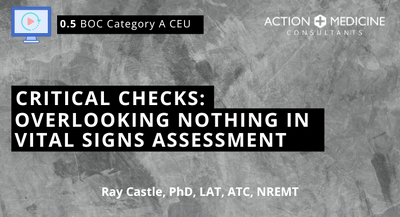General Course Information
Learning Material
Course Info (BOC Domains of Athletic Training; Presentation Description; Learning Objectives; Clinical Practice Gap Statement; Clinical Bottom Line)
BOC Domains of Athletic Training:
- Domain II - Assessment, Evaluation and Diagnosis
- Domain III - Critical Incident Management
Presentation Description:
This course provides an in-depth review of the systematic process for assessing vital signs in patients, particularly focusing on athletes experiencing trauma. It covers the timing for initial and subsequent vital sign assessments and delves into the typical and atypical ranges for both adult and pediatric patients. The course emphasizes the critical role of vital sign evaluation in identifying potential health issues and determining patient status.
Learning Objectives:
- Review the patient assessment process to determine the appropriate timing of initial and follow-up assessment of vital signs used to determine patient status.
- Identify and differentiate typical ranges of vital signs for adults and pediatric patients, emphasizing the importance of these values in assessing patient condition and recognizing deviations indicative of potential health issues.
Clinical Practice Gap Statement:
There is a significant gap in the routine application of systematic head-to-toe assessments and understanding the nuances of vital signs between different patient populations, such as adults and children. This gap can lead to missed or delayed diagnoses, impacting patient outcomes, particularly in emergency or trauma situations
Clinical Bottom Line Statement:
Proper and timely assessment of vital signs is critical in the early detection and management of patients undergoing trauma. Understanding the normal and abnormal ranges of vital signs for different patient demographics is essential for accurate diagnosis and effective treatment planning.


